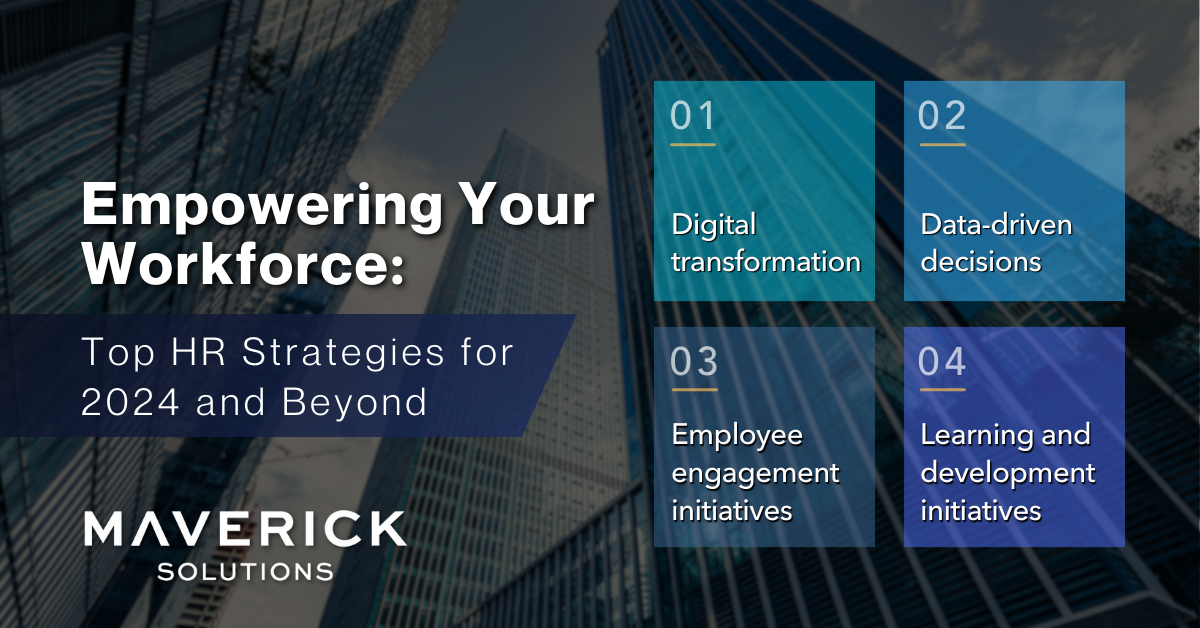

Over the past several years, it’s clear that the world of work is rapidly evolving, and 2024 is no different. Human Resources (HR) departments are at the forefront of this transformation, playing a critical role in shaping the employee experience and driving organizational success. In order to ensure your workforce remains successful and adaptable, organizations must continue to refine and redefine their HR strategies and areas of focus to keep up with ever-changing trends and technologies.
Here are some of the defining HR trends that will lead your organization to a resounding victory in the coming year:
Gone are the days of paper-based processes and siloed data. HR is rapidly integrating technology into day-to-day processes and tasks to improve efficiency. This includes HR strategies like:
Today’s rapidly changing work environment demands a workforce that is continuously learning and adapting. Fostering employee development and learning is a critical responsibility for HR professionals.
By providing employees with opportunities to acquire new skills and knowledge, HR strengthens the organization’s talent pool and ensures its workforce stays current in an ever-changing environment. This not only benefits individual employees by boosting their careers, but also leads to a more engaged and productive workforce. Ultimately, a focus on employee development translates to a competitive advantage for your company.
Forward-thinking HR departments are prioritizing their employee development and learning by utilizing the following HR strategies:
In today’s data-rich world, HR professionals are increasingly relying on people analytics to inform their decisions. People analytics involves collecting and analyzing employee data, such as performance reviews and recruitment surveys, to improve business outcomes.
By utilizing people analytics and data-driven decision-making, HR departments can remarkably improve their efficiency and productivity. Data-driven decisions can optimize recruitment efforts, personalize employee experiences, and improve engagement.
People analytics teams are becoming increasingly more commonplace in today’s workplace, with 70 percent of company executives citing people analytics as a top priority. Organizations that cultivate a data-driven workforce as part of their HR strategy ensure a competitive edge in today’s market.
By leveraging people analytics, HR professionals can gain valuable insights into the following:
In today’s competitive job market, HR professionals must prioritize innovative methods to enhance their employee engagement. A recent report by Gallup indicated that employee engagement is more important than employee work location when measuring employee stress and overall job satisfaction. A highly engaged workforce is not only more productive and satisfied, but also less likely to leave.
By implementing creative HR strategies and taking measures to help employees face present and future challenges, HR professionals can foster a positive work environment, establish a culture of work-life balance, and empower employees This, in turn, leads to a stronger company culture, increased innovation, and overall business success.
With part of 2024 behind us, it is evident that HR professionals play a pivotal role in shaping the future state of their organizations’ workforces. It’s crucial that HR professionals continue to empower their workforce by embracing digital transformation, data-driven decision making, enhanced employee learning, and innovative employee engagement initiatives.
By implementing these HR strategies, HR professionals can create a workforce that is innovative, competitive, and ready for the future.
Request a demo below to see for yourself how Maverick drives engagement within digital transformation, fosters employee development, promotes data-driven decisions, and enhances employee engagement.
Discover how your team can navigate the high cost of compliance technology implementation within Finance.
Learn how Finance leaders are achieving operational efficiency and by empowering their teams with these…
Discover how cloud technology can give your finance team the competitive edge to drive financial…
Discover how to tackle visibility challenges in manufacturing by turning blind spots of outdated systems…
Discover how ERP systems can help Higher Education institutions streamline administrative tasks and provide more…
Discover how legacy systems undermine digital transformation within the manufacturing industry and the cost associated…